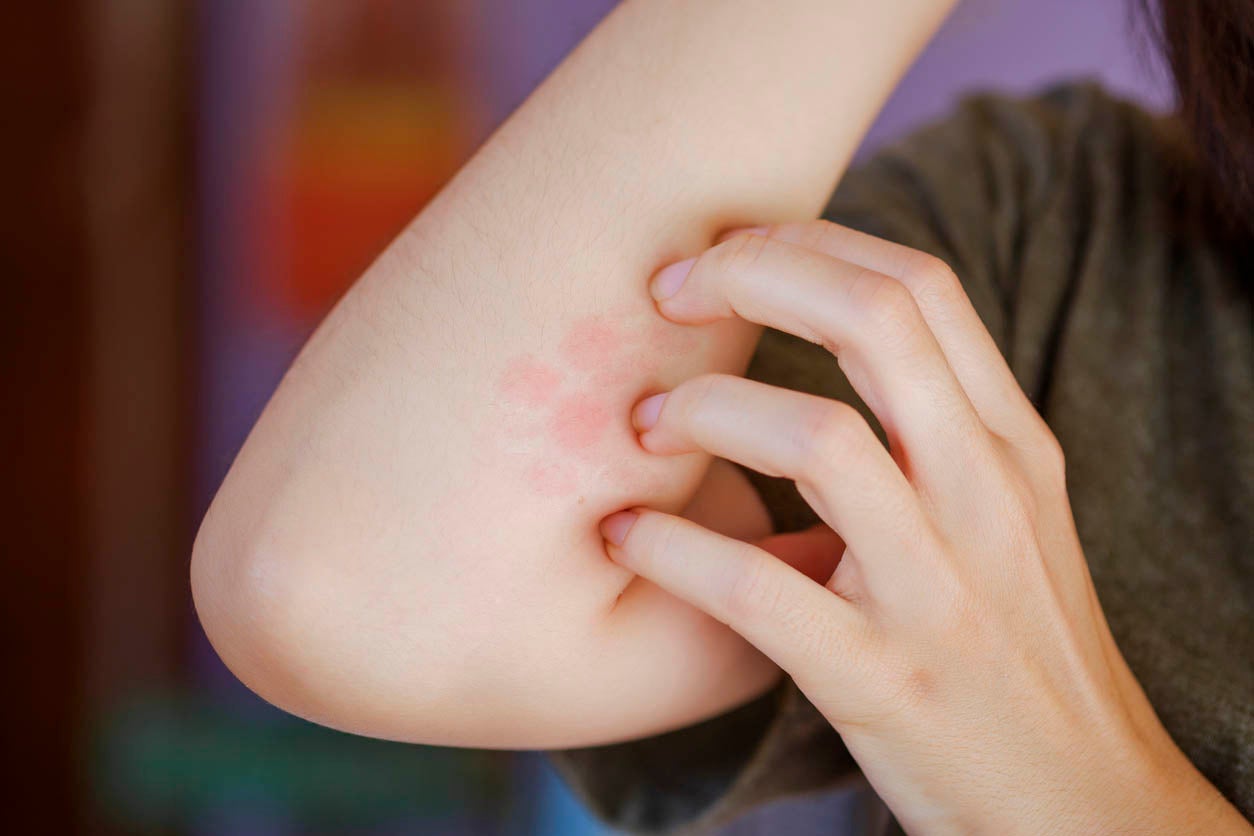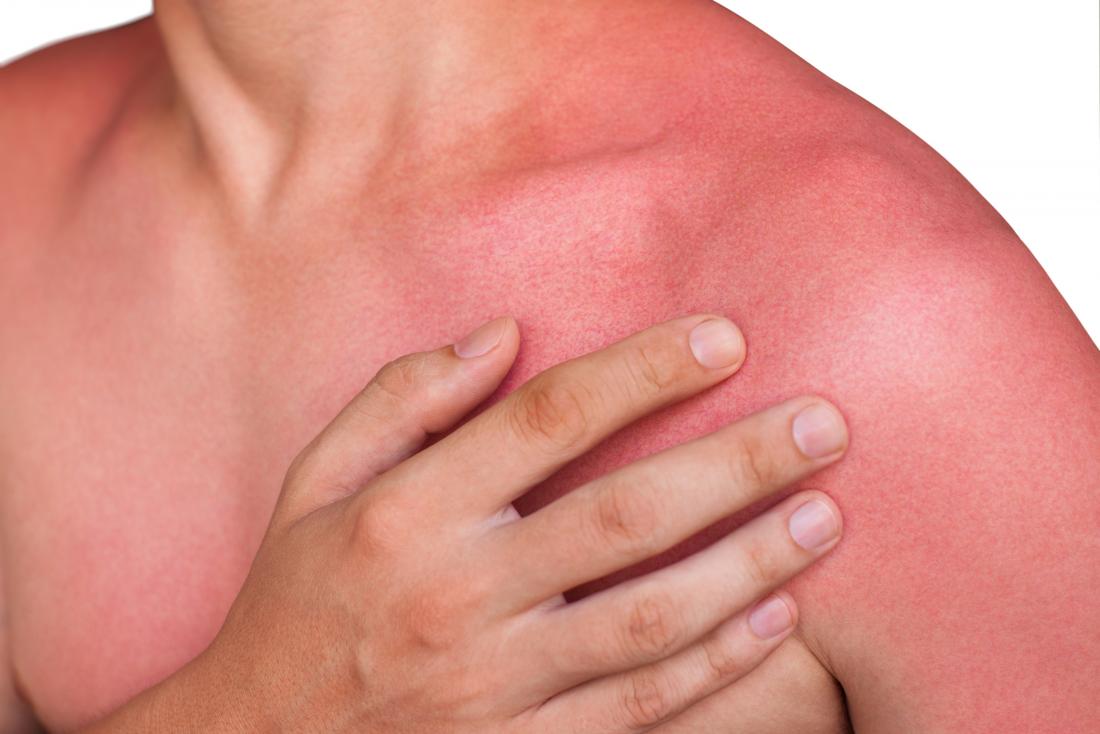Your skin may be red and itchy without bumps due to various reasons such as allergic reactions or skin conditions like eczema. It is vital to determine the exact cause to find appropriate remedies and relief for your discomfort.
An itchy and red skin without bumps can be an irritating and frustrating experience. It can occur for several reasons, including allergic reactions to certain substances like laundry detergents or skincare products, exposure to environmental irritants like pollen or pet dander, or underlying skin conditions such as eczema or dermatitis.
While the absence of bumps may make the cause less apparent, it is important to identify the underlying trigger to alleviate symptoms effectively. We will explore the possible reasons for red and itchy skin without bumps and discuss potential treatment options. So, let's dive in and address the issue at hand.

Credit: www.medicalnewstoday.com
Common Causes Of Red And Itchy Skin
If you've ever experienced red and itchy skin without any visible bumps, you know how uncomfortable and frustrating it can be. But what exactly causes this annoying condition? In this post, we'll explore some of the most common reasons why your skin may be red and itchy, even if there are no bumps in sight.
Allergic Reactions
Allergic reactions are one of the leading causes of red and itchy skin. When your immune system overreacts to certain substances, such as pollen, pet dander, or certain medications, it can trigger an allergic response that manifests as redness and itchiness. These reactions can vary in severity, from mild discomfort to more severe symptoms like hives or swelling.
Allergies can also develop over time, meaning you could suddenly become sensitive to an ingredient in a skincare product you've used for years. To determine if allergies are the culprit behind your symptoms, it's essential to identify any potential triggers and seek advice from a healthcare professional. They can perform tests to pinpoint the specific allergens affecting your skin.
Dry Skin
Dry skin is another common cause of redness and itchiness. When your skin lacks moisture, it can become dry, flaky, and more prone to irritation. Environmental factors like cold weather or low humidity can contribute to dry skin, as can excessive bathing or the use of harsh soaps and cleansers.
To combat dryness, it's important to keep your skin hydrated and moisturized. Look for gentle, fragrance-free moisturizers that lock in moisture without causing further irritation. Additionally, avoiding long, hot showers and using mild, hydrating cleansers can help alleviate dry skin symptoms.
Skin Irritants
Skin irritants can also trigger red and itchy skin, even in the absence of bumps. Various substances, such as certain fabrics, detergents, cosmetics, or even contact with specific plants, can irritate your skin and lead to discomfort. The severity of the irritation can vary depending on your skin's sensitivity and the duration of exposure to the irritant.
If you suspect that your skin is reacting to a specific irritant, it's crucial to identify and avoid it to alleviate the symptoms. Switching to hypoallergenic or fragrance-free products, wearing natural fabrics like cotton, and practicing proper skincare routines can help minimize the risk of skin irritation.
In conclusion, red and itchy skin without visible bumps can stem from various causes, including allergic reactions, dry skin, and exposure to irritants. By understanding these common triggers, you can take steps to prevent and alleviate the discomfort, helping your skin regain its healthy, itch-free state.
Underlying Health Conditions
While redness and itchiness on the skin may sometimes be a result of external factors such as allergens or irritants, there are also several underlying health conditions that can cause these symptoms. In this article, we will explore some of the common health conditions associated with red and itchy skin without the presence of bumps. Understanding these conditions can help you identify the cause of your symptoms and seek appropriate treatment.
Eczema
Eczema, also known as atopic dermatitis, is a chronic inflammatory skin condition that causes red, dry, and itchy skin. It often occurs in patches and can be triggered by various factors such as allergens, stress, or exposure to certain substances. Eczema is commonly found in children, but it can affect individuals of any age.
Some common symptoms of eczema include:
- Itchy and dry skin
- Redness and inflammation
- Thickened or scaly skin
- Cracked or oozing skin
- Sensitive skin
Eczema flare-ups can be managed with proper skincare, avoiding triggers, and using prescribed medications or creams as suggested by a dermatologist.
Psoriasis
Psoriasis is an autoimmune condition that affects the skin, causing rapid skin cell turnover. This leads to the formation of thick, red patches covered with silvery scales. While psoriasis commonly affects the scalp, elbows, and knees, it can occur on any part of the body, including the face.
Some common symptoms of psoriasis include:
- Red patches of skin with silvery scales
- Dryness and itching
- Cracked or bleeding skin
- Thickened or pitted nails
- Joint pain or stiffness (in some types of psoriasis)
Psoriasis can be managed with the help of a dermatologist, who may recommend treatments such as topical creams, medications, light therapy, or systemic treatments depending on the severity of the condition.
Urticaria
Urticaria, commonly known as hives, is a skin condition characterized by raised, itchy welts on the skin. These welts can vary in size and shape and may appear and disappear within hours or days. While hives are often believed to be caused by allergens, they can also be triggered by various factors such as stress, infections, medications, or temperature changes.
Some common symptoms of urticaria include:
- Red or pink raised welts on the skin
- Itching or a burning sensation
- Swelling or inflammation
- The welts may change shape or size and appear and disappear rapidly
Treatment options for urticaria include antihistamines, corticosteroids, or other medications as prescribed by a healthcare professional to relieve the symptoms and address the underlying cause.
Environmental Triggers
There can be several environmental triggers that cause red and itchy skin, even if you don't have any visible bumps. These triggers can range from weather conditions to the chemicals and detergents you come in contact with on a daily basis. Understanding these triggers is essential in managing and preventing uncomfortable skin reactions. In this article, we will explore some common environmental factors that can cause your skin to become red and itchy without any visible bumps.
Weather Conditions
The weather can play a significant role in causing red and itchy skin. Extreme temperatures, excessive humidity, and low humidity levels can all contribute to skin irritation. Cold weather, for example, can lead to dry skin, which in turn can cause itching and redness. On the other hand, hot and humid weather can make you sweat more, leading to an increase in skin irritation and itching.
It's important to protect your skin from harsh weather conditions by taking precautions such as using a moisturizer regularly, wearing appropriate clothing to shield your skin, and avoiding excessive exposure to extreme temperatures. Additionally, staying hydrated by drinking plenty of water can help maintain skin hydration and reduce the risk of dryness and itching.
Chemicals And Detergents
The chemicals and detergents we use on a daily basis can also trigger skin irritation and redness. Many household cleaning products, soaps, shampoos, and cosmetics contain ingredients that can be harsh on the skin and cause allergic reactions. These reactions may result in redness, itching, and even a burning sensation.
It is essential to pay attention to the ingredients in the products you use and opt for hypoallergenic options whenever possible. Avoiding products with fragrances, dyes, and harsh chemicals can help minimize the risk of skin irritation. It is always a good idea to do a patch test before using a new product on your skin to ensure it suits you.
Additionally, when doing household chores or handling chemicals, make sure to wear gloves to minimize direct contact with potentially irritating substances. If you notice your skin getting red and itchy after using a particular product, it's best to discontinue its use and consult a dermatologist if the symptoms persist.

Credit: www.bobvila.com
Treatment And Prevention
Experiencing red and itchy skin without bumps can be uncomfortable, but there are various treatments and preventive measures to help alleviate the symptoms. Moisturizing the skin, avoiding irritants, and using gentle skincare products can provide relief. Consulting a dermatologist can also help identify any underlying conditions and develop a personalized treatment plan for long-term relief.
Moisturize And Protect The Skin
If you're experiencing red and itchy skin without any visible bumps, it's essential to moisturize and protect your skin. Dry skin can lead to irritation and itching, so keeping your skin well-hydrated is crucial. Choose a moisturizer that is gentle on the skin and free from fragrances and other potential irritants.
Apply moisturizer to your skin at least twice a day, focusing on the areas that are particularly red and itchy. Gently massaging the moisturizer into your skin can help enhance absorption and provide soothing relief.
In addition to moisturizing, it's important to protect your skin from potential irritants and allergens. This can be done by avoiding harsh soaps, detergents, and other skincare products that may contain ingredients that irritate your skin. Opt for gentle, hypoallergenic products instead.
If you're spending time outdoors, remember to apply sunscreen with a broad spectrum of SPF 30 or higher to shield your skin from the sun's harmful UV rays. This can prevent further skin irritation and redness.
Identifying Triggers
Identifying triggers that may be causing your skin to become red and itchy can help you take proactive steps to prevent flare-ups. Common triggers include certain fabrics, dyes, perfumes, and even temperature changes.
Consider keeping a journal to track any patterns between your symptoms and potential triggers. This can help you pinpoint specific substances or activities that may be contributing to your skin irritation. Once you identify these triggers, take measures to minimize or avoid them altogether to prevent future episodes of red and itchy skin.
Remember, everyone's triggers can vary, so what causes irritation in one person might not affect another. It's important to pay close attention to your body's unique reactions and make adjustments accordingly.
Consulting A Dermatologist
If your red and itchy skin persists or worsens despite your efforts to treat and prevent it, it may be beneficial to consult a dermatologist. A dermatologist is a skin specialist who can evaluate your condition, offer tailored advice, and prescribe appropriate medications if necessary.
During your dermatologist appointment, be sure to provide detailed information about your symptoms, triggers you have identified, and any treatments you have tried. This will help your dermatologist make an accurate diagnosis and create an effective treatment plan to address your specific needs.
Following your dermatologist's recommendations and staying consistent with your skincare routine can help alleviate redness and itching, promoting healthier, more comfortable skin.

Credit: www.medicalnewstoday.com
Frequently Asked Questions Of Why Is My Skin Red And Itchy But No Bumps?
Why Does My Skin Become Red And Itchy With No Bumps?
When your skin is red and itchy but lacks bumps, it could be due to conditions like eczema, contact dermatitis, or dry skin. These conditions can lead to inflammation and itchiness without causing visible bumps.
What Are The Common Causes Of Red And Itchy Skin Without Bumps?
Some common causes of red and itchy skin with no bumps include allergic reactions, irritants, stress, weather changes, and certain skin conditions like eczema or psoriasis. Identifying the specific cause is important for effective treatment.
How Can I Relieve Redness And Itchiness Without Visible Bumps?
To relieve redness and itchiness without visible bumps, try using a gentle moisturizer, taking cool showers, avoiding irritants, wearing loose clothing, and using over-the-counter anti-itch creams. It's also essential to identify and address the underlying cause with the help of a healthcare professional.
Conclusion
If you are experiencing red and itchy skin without any visible bumps, it could be due to various factors such as dryness, allergies, or skin sensitivities. It's important to identify the underlying cause and seek appropriate treatment to relieve symptoms and prevent further discomfort.
Consulting with a dermatologist will help determine the best course of action for your specific situation. Remember, taking care of your skin's health is essential for overall well-being.






0 Comments